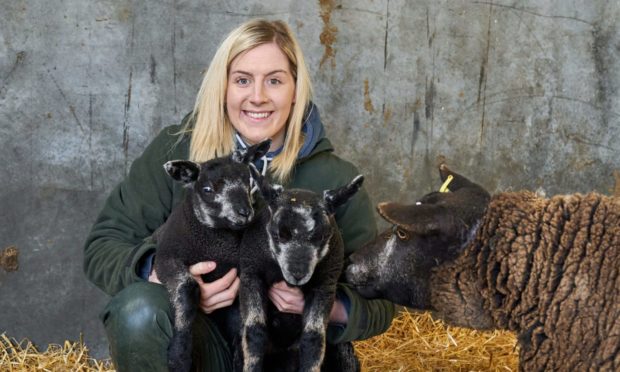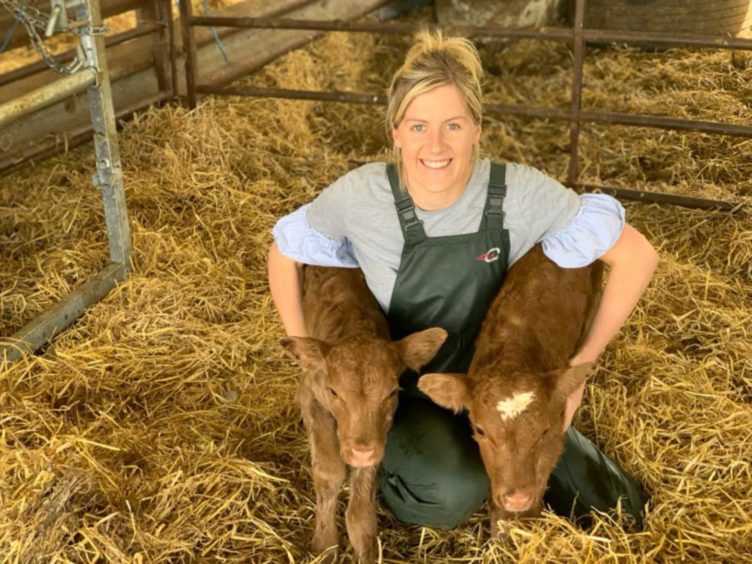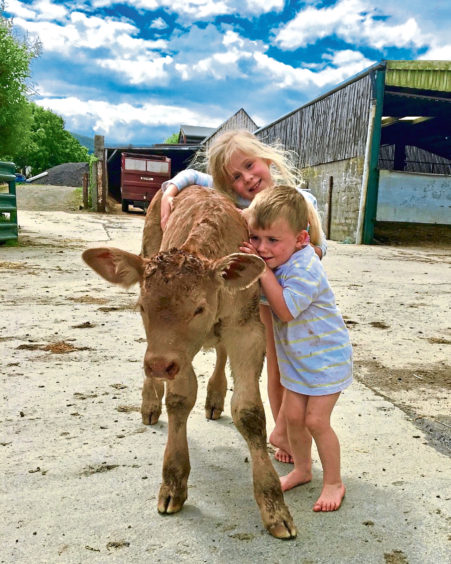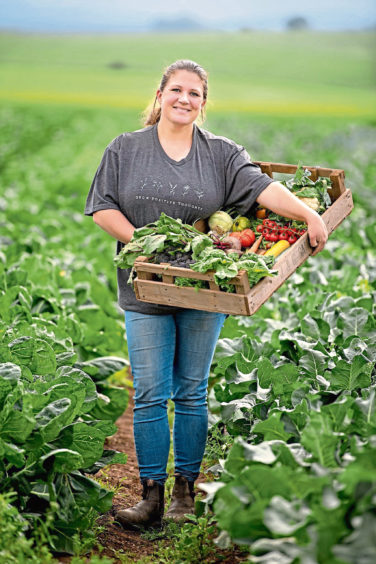Katrina Macarthur is kneeling in the straw with a massive smile on her face, sleeves rolled up and ready for action.
You could say she’s a midwife of sorts, and delivering in tricky circumstances is all part of the job.
The arrival of calves on the Macarthur farm at Cawdor, would once have remained unknown to the rest of the world – only celebrated by 24-year-old Katrina and her family.
But with just a few quick taps, Katrina can share the news with hundreds if not thousands of people.
The freelance agricultural journalist launched an Instagram page on the very first day of lockdown last March.
She juggles reporting for numerous farming publications with working the land alongside her family.
Life on the farm
Katrina hoped to share life on the farm during Covid, but had no idea she would amass more than 2,000 followers.
From school children learning about nature to city dwellers admiring the gorgeous countryside, her page, Feeding The Nation 365, has proved popular with people from around the world.
Katrina, who is third generation on the farm, is part of a growing movement that has seen farmers take to social media to share their day-to-day life.
It’s not all cute lambs in the fields however, with many farmers choosing to share the highs and lows in a bid to make people aware of the reality of farming.
We spoke with farmers across the region who have decided to spread the word, one hashtag at a time.
Katrina Macarthur, founder of Feeding the Nation 365
Katrina’s family have been farming the land at Newton of Budgate for decades, and Katrina helps out with the day-to-day running.
She launched her Instagram page on March 24 2020, having geared up for the busiest time of the year. “I’ll always remember the morning I set it up; it was the very first day of the first lockdown,” she says.
“It was our busiest time of year. We were right in the middle of lambing and calving. I wanted to show people what we were doing when it seemed like the rest of the world had just stopped.
Farming still had to continue – we work 365 days of the year”
Katrina Macarthur
“Farming still had to continue – we work 365 days of the year. Crops were going into the ground, lorries were arriving to drop off feed. Life didn’t stop for us.”
The pandemic was still an uncertain time however, with the family unsure if they would be able to sell cattle at Thainstone Mart.
“We actually had no idea if the cattle were going to sell, and that was a really worrying time for us,” recalls Katrina.
“We thankfully sold the cattle on that first Friday of lockdown, and folk couldn’t believe it. We had to keep going though. We have beef, sheep and arable farming.
“I really didn’t expect the page to get quite this big though.
“People are so interested, and I think even those living in Nairn didn’t really know what goes on at the farm.
“I try to be as educational as possible without going over the top.”
‘Children need to be more educated about farming’
Katrina never plans content, with each post completely off the cuff.
From lambing with Blue Texels to updates from the pigs, Katrina believes every day is different.
“I hope the page has been helpful for parents home schooling, and I’d actually love to go into schools in the future,” she says.
“I think that’s one of the biggest changes we need to make, children need to be more educated about farming.
“People think the lamb just comes out and that’s it. We actually put so much work into the aftercare.
“We’ll start lambing properly in April, and I’ll be helping out a friend in Aberdeenshire as well.
“It’s long shifts, but when it’s your own farm you just keep going.
“We can easily work through the night and be back out at 8am.”
Alongside the sheer amount of hard work, Katrina also tries to show the moments when things don’t go to plan.
“We had a disastrous time last week,” she says.
“One of the lambs was born deformed, and then we lost another one.
“We also had to have a cow put down because she paralysed her back.
“I don’t want everyone to think it’s perfect, and I don’t think people understand the stress involved.
“So that’s why I share the heartache and the financial loss.
“But when people message me to say they love the page, that gives me a real boost.
“One mum said her little girl wakes up every morning, excited to see what we’ve been doing.
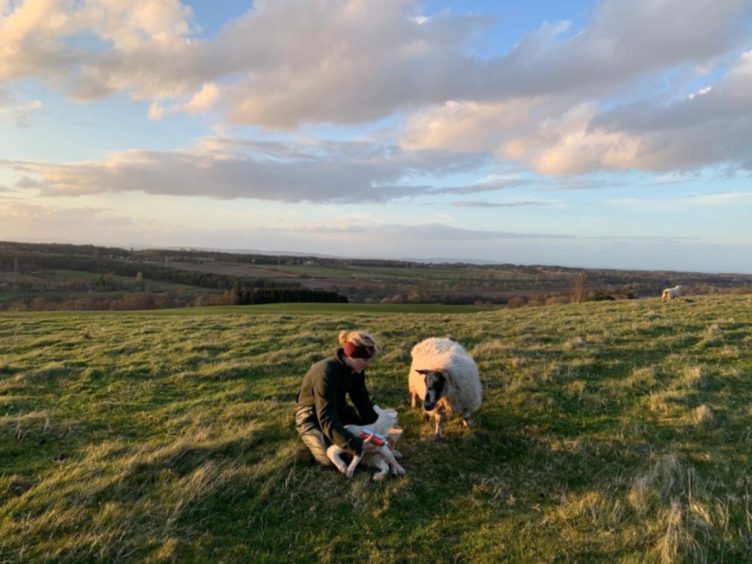
“I think people are appreciating farmers a lot more since the pandemic, and that can only be a good thing.”
• You can follow Katrina at feedingthenation365 on Instagram.
Mel Irvine
Mum-of-two Mel Irvine shot to fame when her family starred in the BBC programme This Farming Life.
Around 2.8 million viewers tuned in to watch Mel and her husband, Martin, get married in one episode – and the couple are now used to getting recognised while doing the weekly shop.
They haven’t let stardom go to their heads however, and life has carried on as normal on their farm at Drummuir, near Keith.
Mel decided to set up an Instagram page in 2013, and admits she was only persuaded to do so by friends.
More than 8,000 people now follow the highs and lows of the Irvine family online, and Mel believes social media has been particularly important during the pandemic.
Some posts can attract hundreds of likes and comments, but Mel is keeping her wellies planted firmly on the ground.
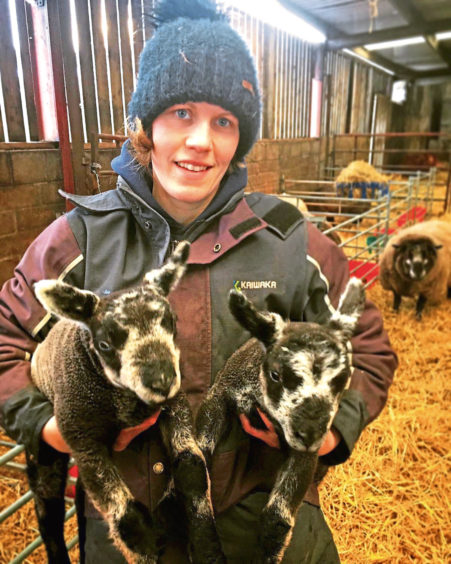
“I don’t tend to look at how many likes each post gets,” she says.
“At the start, Instagram was just another social-media platform for me.
“I wanted to show what farming can be like day to day. Having appeared on This Farming Life, we had already let the public into our world.
“I don’t do planned content. I see pictures where someone has baked a lovely cake and put it on a pretty plate, with a vase of flowers in the background. That just isn’t me. I post about treating sheep for maggots, before deciding what the kids are going to have for tea.
“I never really think about it, that’s just what our life is.”
I think there is definitely a movement with farmers showing their work on Instagram.”
Mel Irvine
Alongside helping out on the farm, Mel is kept busy with three-year-old Matthew, and Erin, who is almost five.
It is clear the pair are following in their parents’ footsteps, and pictures of them lending a hand adorn Mel’s Instagram grid.
“We don’t take ourselves too seriously, and I think people can tell that from the pictures and videos I post,” says Mel.
“I think there is definitely a movement with farmers showing their work on Instagram.
“The younger generation are possibly more keen in comparison.
“It always reminds me of that phrase; one of the most expensive things you can say is that we’ve always done it this way.
“You have to look outside the box and Instagram can become your shop window.
“If other people can promote their business online, why shouldn’t farmers do it?
“We’ve been marketing our bulls on Facebook during the pandemic, and we’ve been quite successful.
“If you live in a high-rise flat, for example, you’ve probably never seen a lamb or calf born.
“Some children grow up not knowing where milk comes from. It’s everyday to us, but totally new to them.
“If we can get that message across via social media, this is how your food is raised.
“If someone watches one of my videos and it makes them go to a butcher, well that’s brilliant.
“We have to try and promote what we do, particularly through the pandemic.
“And if I make someone laugh in the process, that’s great.”
• You can follow Mel at mel_irvine on Instagram.
Fiona Smith, Westerton Farmers
Life is pretty hectic for Fiona Smith and her husband Douglas, who farm in South Aberdeenshire.
They’ve had no choice but to get to work in temperatures of -17.5C in recent weeks, because jobs don’t wait for the weather to improve.
They’ve been rushed off their feet during the pandemic, after a fledgling business took off.
“We’re a bit unusual in that Douglas works with his parents, whereas I still farm with my dad,” says Fiona.
“I’m fourth generation, and my family bought the main part of the working farm in 1920.
“Westerton Farm is arable, meaning it’s all crops.”
Fiona opened The Spud Hut in 2017, as a way to sell a variety of homegrown produce.
“We took £1.75 on our first day of trading; turnover has thankfully improved since then,” she says.
“We are very lucky in that people have really needed us during the pandemic, and business has been fantastic.”
Word of mouth means The Spud Hut is rarely quiet, and Fiona has documented their working life via an Instagram page.
She now has more than 2,000 followers, and believes social media can be a real positive for farmers.
It takes time and skill to grow food, and to work on the farm in general.”
Fiona Smith
“We’re not a big account by any means, but I am still amazed that 2,000 people want to see what we’re doing each day on Instagram,” she says.
“There’s more than 4,000 people on our Facebook page as well.
“I love how interested people now are in where their food comes from, and what is involved in getting it on their plate.
“It takes time and skill to grow food, and to work on the farm in general.
“You need to know machinery inside out, be a vet and a tax pro. There is so much involved.
“Farming doesn’t stop, because it can’t. I think farmers were seen as the bad guys for so long, and now people are starting to appreciate us.”
Fiona has also been involved with giving virtual tours of the farm, and is hopeful that once restrictions allow, people will be able to visit in real life.
“We did a live tour for my son’s nursery class, and then we did some more tours through Go Rural Scotland,” she says.
“Farming can be quite an isolated industry, and the public wouldn’t normally get to see what goes on.
“People have asked some brilliant questions about soil types, variety of crops and food miles.
“Prior to Covid, my dad gave talks in school. One little boy thought potatoes were made with butter and milk.
“I think when used correctly, social media can be a fantastic platform. You reach people of all ages, and we’d love to get other farms involved in doing tours.
“Every day, something different is thrown at us. We’ve never worked in a pandemic before, or in temperatures of -17.5.
“But we carry on, and I think social media can clearly demonstrate that.”
• You can follow Fiona at westertonfarmers on Instagram.
